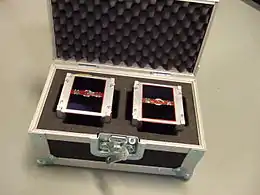AAUSAT-II
AAUSAT-II is the second student-built CubeSat built and operated by students from Aalborg University in Denmark. It was launched 28 April 2008 05:54 UTC from Satish Dhawan Space Centre in India on a PSLV rocket. AAUSAT-II carries a radiation sensor.
 AAUSat II, alongside its engineering model, ahead of launch | |
| Mission type | Technology |
|---|---|
| Operator | AAU StudentSpace |
| COSPAR ID | 2008-021F |
| SATCAT no. | 32788 |
| Website | www |
| Mission duration | 6 months planned |
| Spacecraft properties | |
| Spacecraft type | 1U CubeSat |
| Manufacturer | AAU StudentSpace |
| Launch mass | 3.0 kilograms (6.6 lb) |
| Start of mission | |
| Launch date | 28 April 2008, 03:53:51 UTC[1] |
| Rocket | PSLV-CA |
| Launch site | Satish Dhawan SLP |
| Contractor | ISRO |
| Orbital parameters | |
| Reference system | Geocentric |
| Regime | Sun-synchronous |
| Perigee altitude | 604 kilometres (375 mi) |
| Apogee altitude | 622 kilometres (386 mi) |
| Inclination | 97.72 degrees |
| Period | 96.82 minutes |
| Epoch | 21 January 2014, 18:39:39 UTC[2] |
The educational objective
The primary purpose of construction of satellites at Aalborg University is to give the students engineering capabilities beyond what is normally achieved within a masters program.
History
Student satellite activities at Aalborg University (AAU) started in 2003 as a result of AAU's involvement in the first pure Danish research satellite, Ørsted, which was successfully launched in 1999.
AAUSAT-II's predecessor was AAU CubeSat which was constructed in the period 2001-2003 and was launched 30 June 2003.
The construction of AAUSAT-II began in 2005.
Operations
After launch April 28, 2008 AAUSAT-II beacon was received at Cal Poly University in California but two-way amateur radio communications could not be achieved as it turned out that AAUSAT-II was transmitting at a lower level than anticipated. After upgrades to the ground station were completed, fully functional two-way communication were achieved and continued with normal operations until May 2009 after a year of successful operation.
The ground station has remained in operation and beacons are received on a regular basis and AAUSAT-II is still considered operational - although heavy tumbling is observed (December 2009)
Beacons are still received on regular basis in March 2011. In addition AAUSAT-II does receive and acknowledge commands from ground and log files has been requested and received. Due to the very high tumbling (more than 2.5 Hz) it has not been possible to decode log files.
Below is a snapshot of the radio communication. On left side is a beacon, next a request for log is issued and AAUSAT-II reply with a transmission of the logfile. Notice the high tumbling rate.
Mission definition
AAUSAT-II consists of several sub-systems:
- ADCS: Attitude Determination and Control System
- CDH: Command and Datahandling System
- COM: Communication System
- EPS: Electrical Power System
- GND: Ground Station
- MCC: Mission Control Center
- MECH: Mechanical System
- OBC: On-board Computer System
- P/L: Payload System
Technical Facts:
| Dimensions | 100 × 100 × 113 mm Cubesat standard |
| Mass | 750 gram |
| Expected lifetime | Minimum 1 month, extended until end of lifetime |
| Attitude determination system | Sun sensors, gyro sensors, magnetometers |
| Attitude control system | Momentum wheel and magnetic coils |
| Power | Solar-cell panels located in satellite surface |
| Batteries | Li-ion 8.2V 2200 mAh |
| Power bus | 3.3 and 5V regulated |
Amateur radio information
- Callsign: OZ2CUB
- Up/downlink: 437.425 MHz AFSK & FSK
- Bit rate: 1200-9600 bit/s (1200 as standard mode)
- AX.25 FM CW TLM
See also
References
- McDowell, Jonathan. "Launch Log". Jonathan's Space Page. Retrieved 22 January 2014.
- "AAUSAT CUBESAT 2 Satellite details 2008-021F NORAD 32788". N2YO. 21 January 2014. Retrieved 22 January 2014.